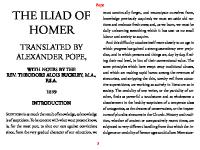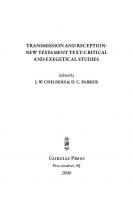Studies in the Text and Transmission of the Iliad 9783110963120, 9783598730054
In den jahrzehntelangen Vorarbeiten zu seiner weltweit so beachteten Homerausgabe hat der Editor viele interessante und
176 60 27MB
English Pages 311 [312] Year 2001
PART I. THE TRANSMISSION
1. The Pre-Alexandrian Transmission
2. Zenodotus’ Text
3. Didymus and his Sources
4. The Papyri
5. The Early Medieval Transmission
6. The New Teubner Edition
PART II. THE TEXT
Notes on Individual Passages
BIBLIOGRAPHY
INDEXES
Recommend Papers

- Author / Uploaded
- Martin L. West (editor)
File loading please wait...
Citation preview
Studies in the Text and Transmission of the Iliad
Studies the Text and Transmission of the Iliad By Martin L. West
G • Saur Miinchen • Leipzig 2001
Die Deutsche Bibliothek - CIP-Einheitsaufnahme
West, Martin L.: Studies in the text and transmission of the Iliad / b y M a r t i n L. West. M ü n c h e n ; Leipzig : Saur, 2001 I S B N 3-598-73005-5 © 2001 by K. G. Saur Verlag G m b H , M ü n c h e n u n d Leipzig Printed in G e r m a n y Alle Rechte vorbehalten. All Rights Strictly Reserved. Jede Art der Vervielfältigung ohne Erlaubnis des Verlages ist unzulässig. Gesamtherstellung: D r u c k h a u s „Thomas M ü n t z e r " G m b H , 99947 Bad Langensalza
Preface These studies are a by-product of my recent critical edition of the Iliad in the Bibliotheca Teubneriana (Stuttgart-Leipzig-Miinchen, 1998-2000). Part I is largely an amplification of the first twelve pages of the edition's Praefatio. It also contains a fuller list of the papyri, and an account of the aims and methods of the edition. Part II consists of textual discussions of individual passages, mostly amplifying hints already given in the critical apparatus. I should like to take the opportunity to thank the publisher and his officers, not only for being so ready and willing to produce the present volume, but also for the care which they devoted to producing the second volume of the edition, beautifully completing what the firm of B. G. Teubner had begun. December 2000
M. L. W.
Contents PART I. T H E TRANSMISSION 1. 2. 3. 4. 5. 6.
The Pre-Alexandrian Transmission Zenodotus' Text Didymus and his Sources The Papyri The Early Medieval Transmission The N e w Teubner Edition
3 33 46 86 139 158
PART II. T H E TEXT Notes on Individual Passages
173
BIBLIOGRAPHY
286
INDEXES
290
PART I THE TRANSMISSION
1. The Pre-Alexandrian Transmission The Iliad that is the object of our studies is a written text. It is the creation, we presume, of a poet trained in the techniques of oral performance and accustomed to deliver his poetry orally; a poet who composed his verses, not without premeditation, but with considerable fluency, line by line rather than word by word. However consistently he kept to one version of the stories he told, there will have been variations of scope and of detail between each performance and the next. Fixity could come only when a text was written down. In principle it can happen that the same oral poem is written down at different times, in different places, or from the lips of different bards. This results in texts that may diverge substantially in the sequence of episodes, in narrative detail, or in other respects. But in the case of the Homeric poems there is no good evidence that such divergent recensions were ever current. Apparently each epic was written down only once, or if other versions ever existed, they disappeared at an early date. Our Iliad took on its definitive form as it was written down.1 It is my conviction that the process of writing it down was intermittent and extended over many years. In any case it was the completion of the writing down that marked the completion of the composition. That is where the story of the transmission begins.
The primal
text
The first complete text probably consisted of a collection of papyrus rolls. (Parchment is also possible.) We should not imagine them to be twentyfour in number; the division of the poem into twenty-four 'books', as they are commonly called, or pouyooiSiou, as they were called in antiquity, was made at a later time and for a different purpose, as will be argued below. In any case this original text did not yet contain the Doloneia, which makes up one of the twenty-four sections of the Iliad as it has come down to us. It may be assumed that each verse was written on a separate line, according to the standard Greek practice attested since the time of the 'Nestor's
1 This essential point was established once and for all by Adam Parry in his famous paper 'Have we Homer's Iliad}' in Yale Classical Studies 20 (1966), 177-216; reprinted i n j . Latacz, Homer. Tradition und Neuerung (Wege der Forschung, 463: Darmstadt 1979), 428-66.
4
1.1. T h e P r e - A l e x a n d r i a n T r a n s m i s s i o n
cup' inscription from Ischia.2 In the mid seventh century the text would have been written from right to left or boustrophedon. The latter is commoner in the inscriptions, but the three verses of 'Nestor's cup' are all written from right to left, and this might reflect a practice established for books of verse. The use of punctuation to divide words or phrases is also possible, but we cannot assume any other kind of formatting. The script used would have depended on where the poet, or his amanuensis, learned to write. I accept the usual view that he was an Ionian who spent his life largely or wholly in western Asia Minor, moving between the Maeander valley and the Troad. If so, he is likely to have used an East Ionic alphabet of twenty-five letters (with eta, qoppa, and omega).3 Even if there is truth in the ancient and modern theory that certain errors arose in the transmission through misinterpretation of texts in which E stood for both e and ri and O for both o and to, it need not follow that such ambiguities were a feature of the earliest texts: they may have been first introduced in early Athenian copies made in the local Attic alphabet. I will discuss the question later in connection with the Attic phase of the transmission. If we may argue from the usual practice of early inscriptions, doubled consonants would have been written single, so that, for example, 'AxiXeug and 'AxiXXeug would both have been written Axi^eug. The unvoiced velar stop was represented by qoppa before a back vowel (o or u): rXoio9








![The Transmission of the Text of Lucan in the Ninth Century [Reprint 2014 ed.]
9780674282124, 9780674282117](https://ebin.pub/img/200x200/the-transmission-of-the-text-of-lucan-in-the-ninth-century-reprint-2014nbsped-9780674282124-9780674282117.jpg)
